Top News
April 18, 2015 Ryukyu Shimpo
The Henoko Fund, which was set up to try to prevent construction of a new U.S. airfield in Henoko, Nago on April 9, has raised 46,291,683 yen in one week. The Governments of Japan and the United States plan to move U.S. Marine Corps Air Station Futenma in Ginowan to the facility. The executive committee of the fund plans to publish advertisements in newspapers in the United States before Okinawa Governor Takeshi Onaga’s visit to Washington DC in late May.
Bunyo Ishikawa, a famous photographer from Okinawa who documented the Vietnam War, has become a representative of the fund. The other representatives are: former Kadena Mayor Tokuzitu Miyaga; Morimasa Goya, chairman of Kanehide Group; Chokei Taira, CEO of Kariyushi Group; Tokumatsu Nagahama, chairman of Okinawa Ham Co.; Masaru Sato, writer and former chief analyst at Foreign Ministry; and Fumiko Sugawara (the widow of late actor Bunta Sugawara).
(English translation by T&CT)
Go to Japanese
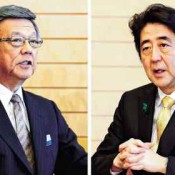
April 18, 2015 Ryukyu Shimpo
Okinawa Governor Onaga met with Prime Minister Shinzo Abe on April 17 at the Prime Minister’s Office in Tokyo. Onaga asked Abe to cancel the relocation of U.S. Marine Corps Air Station Futenma in Ginowan to Henoko, Nago. He showed his strong opposition to the construction of the new base in Henoko. He said to the prime minister, “I will absolutely not allow the building of a new base,” and asked the prime minister to convey his message to President Barack Obama in the Japan-U.S. Summit meeting to be held on April 28 in Washington DC.
The prime minister said, “Relocating the Futemma base to Henoko is the only solution.” Abe indicated he would carry out the plan to relocate the Futenma base to Henoko. This was the first meeting between them since Onaga took office in December last year.
The meeting was held for about 30 minutes. Only six minutes after the beginning it was opened to the press. In the middle of the governor’s speech to the prime minister, the government officials closed doors to exclude the press. However, the Okinawa Prefectural Government has published an outline of what the governor said to the prime minister. According to it, the governor stated that if the government forces through the reclamation work without obtaining an understanding from residents, he would absolutely not allow the new base to be built at Henoko.
At the beginning of the meeting, the governor stated that an overwhelming majority of public opinion opposed the new Henoko base. This was demonstrated by candidates who oppose the Henoko relocation winning elections last year, including the Nago mayoral election, the gubernatorial election and the House of Representatives election.
“While the government took over land for military use from local people, it demands the Okinawan people host a new U.S. base to replace the aging Futenma base, which is the most dangerous base in the world, or else they have to offer an alternative plan. It is an unreasonable demand,” the governor said, criticizing the prime minister for his hard-line policy on Henoko.
The government has claimed that it obtained consent from local authorities to reclaim the sea off Henoko based on a 1999 cabinet decision. At the time, then Governor Keiichi Inamine and then Nago Mayor Tateo Kishimoto accepted the Henoko relocation plan with conditions such as a new airfield for joint military-civilian use for 15 years.
Onaga said the government’s claim was wrong because the 1999 cabinet decision lapsed in 2006, and conditions since then have changed.
At the start of the meeting, the prime minister said, “We agree on the idea that the Futenma base should be removed to reduce the risk as soon as possible.” He said he would continue his efforts to gain an understanding from Okinawa. After the meeting, the governor commented to reporters, “Our ideas are different from each other. However, it was meaningful to have discussed the issue.”
Chief Cabinet Secretary Yoshihide Suga and Deputy Governor Mitsuo Ageda attended the meeting.
(English translation by T&CT)
Go to Japanese
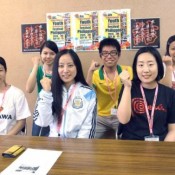
April 9, 2015 Ryukyu Shimpo
The 4th Worldwide Youth Uchinanchu Festival is to take place in Manila from September 10 to 15, 2015. It aims to help participants learn about the current situation in developing countries, including the problems of poverty and environmental degradation. The World Youth Uchinanchu Association announced the festival dates on April 8 and said it would be calling for participants from the end of the month.
Minami Tamamoto, chairperson of the association’s executive committee, said “We want to make the Youth Uchinanchu Festival a success. We would like it to have a more global perspective.”
Hayato Higa, a student of Okinawa International University looked forward to the festival, saying “I want to develop relationships with other delegates so we can work together in the future.” It’s hoped participants will be able to take part in a camp to help get to know each other. The committee is also planning to organize a tour in the Philippines.
Around 20 young people from Okinawa between the ages of 18 and 35 will take part in the festival. They will be joined by 30 delegates from other countries, along with 50 observers. The executive committee is calling for companies to support the festival. For more information please contact Hayato Higa ( 080 8386 6348.)
(English translation by T&CT, Hitomi Shinzato)
Go to Japanese
April 9, 2015 Wu Li Jun of the Ryukyu Shimpo
CNN’s “Travel + Leisure” website has ranked Shurijo Castle in Naha City as the 10th most visited Palace or Castle in the world. The ranking is based on visitor numbers obtained from tourist and government sources. Shurijo is the only monument in Japan to make the top ten.
The Forbidden City in Beijing, China, took first place with 15.34 million annual visitors. It was followed by the Louvre Museum in Paris, France, (9.33 million) and the Grand Palace in Bangkok, Thailand (8 million.) Around 1.753 million people visit Shurijo Castle every year.
The website also provided a brief history of Shurijo, explaining how it was the seat of the Ryukyuan kings for over 400 years before being completely destroyed during the Battle of Okinawa in 1945. It was rebuilt in 1992.
(English translation by T&CT and Sayaka Sakuma)
Go to Japanese
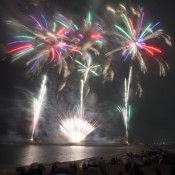
April 12, 2015 Ryukyu Shimpo
Tens of thousands of fireworks lit up the skies over Ginowan on the evening of April 12. Despite persistent rain, spectators at the Ryukyu Kaien Festival were treated to a spectacular display synchronized to music. One of the fireworks was produced by highly acclaimed fashion designer, Junko Koshino.
With the catchphrase, “The earliest summer firework display in Japan,” the festival is held annually in April at Ginowan Seaside Park.
Urasoe resident Shogo Kinjo was one of those who enjoyed the event. “Even with the rain, I was overwhelmed by the fireworks and music,” he said.
(English translation by T&CT)
Go to Japanese
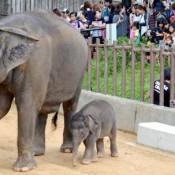
April 12, 2015 Ryukyu Shimpo
Visitors to Okinawa Zoo and Museum got their first chance to meet a new baby Indian elephant on April 11. About 500 people turned up to catch a glimpse of the female calf and her mother Ryuka. The baby spent much of her time in the spotlight snuggling up to her mother, to the delight of the spectators. “She’s cute” said one, while another remarked, “She is so small.”
The zoo is inviting suggestions for the baby elephant’s name. The closing date is May 10, two weeks before the naming ceremony on May 24. In the meantime the public have the chance to see the elephants between 11am and 3pm every day.
One of the zoo staff Kai Nakama, says the baby elephant has taken to “playing soccer” with a cardboard box. He said she also responds to sound and added, “She looked surprised by the number of people who gathered here today to see her.”
Five-year-old Miryu Meshiro who was visiting the zoo on an excursion said, “She is cute. I want her name to be Rimi or Tampopo (dandelion).”
(English translation by T&CT)
Go to Japanese
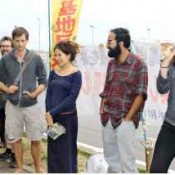
April 12, 2015 Ryukyu Shimpo
Young foreign scholars and a journalist living in Okinawa visited the sit-in protest site at U.S. Marine Camp Schwab in Henoko, Nago, on April 11. The visitors came from Scotland, India, Switzerland, the United States, Taiwan, and Australia. Australian journalist Jane Close encouraged the protesters, saying, “Many people from other countries sympathize with Okinawa.” She said, being scheduled to return to Australia, “I would like to continue supporting Okinawan people’s struggle against the expansion of US military on the island, through social media such as twitter and Facebook .”
Zach Hensel, a biophysicist from the United States, said, “I’m ashamed that my country put Okinawa and the Okinawan people in danger by secretly keeping nuclear weapons in Okinawa and conducting illegal bombing in Southeast Asia from Okinawa. America should leave Okinawa – not build new bases.”
He gestured his opposition to the new base making an X sign with his arms.
They each made short speeches, saying that “Oura Bay is a treasure” and that “we have to raise awareness about this issue around the world.” The sit-in protesters responded to them, saying, “let’s work together to block the construction of a new U.S. base.”
(English translation by T&CT)
Go to Japanese
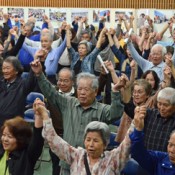
April 9, 2015 Ryukyu Shimpo
Grass roots organizations are springing up in municipalities across Okinawa to oppose the construction of a new U.S. base at Henoko.
In Chatan about 160 people, including residents and town council members, got together to form the Chatan Town Citizen’s Forum on April 8. Mayor Masaharu Noguni addressed the inaugural meeting, “We are uniting to do something concrete to prevent the construction of the new U.S. base.”
A similar organization is to be created in Nakagusuku by the end of April, bringing together villagers, the municipal government’s labor organization and assembly members. The new group will take part in the Okinawan People’s rally, scheduled to take place at Okinawa Cellular Stadium in Naha in May.
Community groups and local politicians in Okinawa City are to have a meeting in mid-April to discuss how they can set up their own anti-Henoko organization. Likewise, plans are underway for meetings in Ginowan City and Nakijin Village.
(English translation by T&CT)
Go to Japanese
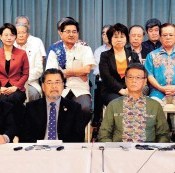
April 10, 2015 Ryukyu Shimpo
A new fund has been established to prevent the construction of a new U.S. base in northern Okinawa. The governments of Japan and the United States are planning to move U.S. Marine Corps Air Station from Futenma in Ginowan to a new base in Nago. The “Henoko fund” was set up on April 9 by businesspeople and members of the Prefectural Assembly’s ruling parties. They aim to raise several hundred million yen from supporters both inside and outside Okinawa.
The founding board members support the Okinawa Prefectural Government’s position that Futenma air station should be either transferred to another prefecture, or relocated overseas. They intend to use the fund to show people in the rest of Japan and abroad that Okinawa opposes the Henoko base plan. Okinawa Governor Takeshi Onaga is considering becoming an adviser to the fund on a personal basis.
Former Kadena Mayor Tokuzitu Miyaga, Morimasa Goya, chairman of Kanehide Group, Chokei Taira, CEO of Kariyushi Group, Tokumatsu Nagahama, chairman of Okinawa Ham Co., Masaru Sato, writer and former chief analyst at Foreign Ministry and Fumiko Sugawara (the widow of late actor Bunta Sugawara) have become joint representatives of the fund. Governor Onaga also attended the press conference to launch the fund on April 9 in Naha.
The founding members will hold a general meeting in May to discuss their plans. They said the fund would help support campaigns, including publishing advertisements in newspapers in Tokyo and the United States, and carrying out lobbying activities in the U.S.
Former Kadena Mayor Miyagi said, “The governments of Japan and the United States have an authority to decide the Futenma Issue but we cannot entrust everything to them.” He insisted that Okinawan people could take some control of the issue through the fundraising campaign.
Governor Onaga was “truly touched” by the fundraising campaign. “It has renewed my determination on this issue,” he said.
(English translation by T&CT)
Go to Japanese
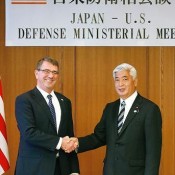
April 8, 2015 Ryukyu Shimpo
The U.S. Defense Secretary has reiterated his support for relocating Futenma base to Henoko. Ashton Carter made the comments during a meeting with Defense Minister Gen Nakatani in Tokyo on April 8.
Nakatani began the meeting by saying, “The Japanese government will steadily carry out the plan to relocate U.S. Marine Corp Air Station Futenma to Henoko, Nago to reduce the burden on Okinawa and to maintain a deterrence capability based on the two-plus-two meeting held in 2013.” Carter stated that it was important to move forward with the realignment of U.S. forces in Japan, including the relocation of Futenma Air Station, in order to uphold the Japan-U.S. alliance.
Carter also said that revising U.S.-Japan bilateral defense cooperation guidelines could have a big influence on the world. He added that the revised bilateral defense guidelines would contribute not only to peace and stability in the Asia Pacific region but would also strengthen the Japan-U.S. alliance. The two agreed to settle the matter as quickly as possible before a so-called “two-plus-two meeting,” between U.S. and Japanese foreign and defense ministers, is held in Washington D.C. at the end of April.
(English translation by T&CT)
Go to Japanese
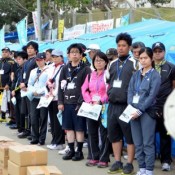
April 9, 2015 Ryukyu Shimpo
About 130 people from the Okinawa company Kanehide Holdings, including the chairman Morimasa Goya, have taken part in a protest against ongoing construction work at Camp Schwab in Henoko. Company executives along with new employees joined demonstrators outside the camp’s main gate on the morning of April 9. The Okinawa Defense Bureau is continuing preliminary work at Henoko as part of its plan to build a replacement facility for U.S. Marine Corps Air Station Futenma.
Representing the new employees, Masato Uechi delivered a speech. He said, “Although I knew about the Henoko protest from TV and newspaper coverage, it is really impressive to see it firsthand.” He continued, “This has become a big movement because lots of individuals are working together. The sky is the limit. I hope more young people will take part and change the situation.”
After 6 a.m., the protesters began preventing vehicles from entering the base. They also criticized Prime Minister Shinzo Abe for supporting the Henoko relocation plan.
Workers employed by the Defence Bureau used two marine construction barges and a crane barge off the coast of Henoko. While on the land around the Henokozaki cape where the bureau plans to build a temporary pier, construction workers operated heavy machinery. Protesters in four boats and 13 canoes claimed to have halted the work temporarily. They were later forcibly removed from the scene by Japan Coast Guard officers in inflatable rafts. The situation remained tense.
(English translation by T&CT)
Go to Japanese









 Webcam(Kokusai Street)
Webcam(Kokusai Street)


